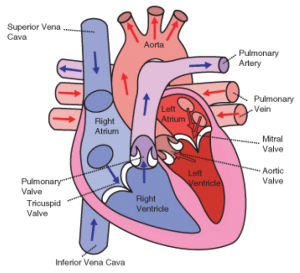Mitral Valve Insufficiency & Congestive Heart Failure

The heart is a mechanical pump that accepts low-oxygen / high carbon dioxide blood into the right atrium and through the right atrioventricular valve into the right ventricle. It is then pumped into the lungs through the pulmonary artery – the only artery in the body that carries non-oxygenated blood. In the lungs carbon dioxide is replaced with oxygen. The re-oxygenated blood then moves through the pulmonary vein back into the heart and enters the left atrium. This chamber pumps the blood through the mitral valve into the left ventricle, which is the largest, most heavily muscled chamber of the heart. The left ventricle then forces the blood through the entire body via the aorta.
Heart failure in older dogs is usually due to problems with the mitral valve of the heart, and occurs most commonly in smaller breeds. As the dog ages, the mitral valve starts to fail, and once the ventricle is filled the valve fails to completely close off the area on the left side of the of the heart between the two chambers. This means that as the left ventricle contracts to pump blood round the body, it also forces a portion of the blood backwards into the left atrium with each heartbeat. This causes the blood pressure in the left atrium to increase, and also further back into the lung. As the right side of the heart then tries to pump blood forward into the lungs for oxygenation it is met with increased blood pressure and so the right side of the heart must work harder to move blood into the lungs.
When hypertension (higher than normal blood pressure) occurs within the lungs, fluid leaves the blood vessels and leaks into the tissues – this is referred to as ‘fluid in the lungs’ or ‘pulmonary edema’. This causes difficulty in breathing and coughing in an attempt to clear the lungs of the fluid. The cough typically occurs after exercise, excitement, or when the dog first gets up after sleeping.
As the condition increases, the right side of the heart starts to fail because of its increased work and elevated pressure. At first the muscles strengthen, however over time the muscles cannot keep up with the ever-increasing pressure and they start to fail. This failure of the heart to provide the tissues with adequate oxygen and nutrients is the start of congestive heart failure, and the dog will be weaker and tire more easily. The systemic blood pressure (blood pressure in the body versus the lungs or heart) may also be low, whilst the heart rate and respiratory rate are often elevated. The body’s cells will become distressed and trigger a series of responses – various hormones are released in an attempt to increase blood oxygen levels and blood circulation. These hormones conserve fluid in an attempt to increase blood volume and the output of blood and oxygen by the heart.
The first sign of a problem with the mitral valve is a heart murmur – this is produced by the turbulence created when some of the blood goes backward through the leaking mitral valve into the left atrium. Mitral valve insufficiency is asymptomatic (i.e. produces no obvious clinical signs), but the heart murmur can be detected by listening to the dog’s heart with a stethoscope.
As Mitral Valve Insufficiency progresses into Congestive Heart Failure, early symptoms that may occur are exercise intolerance, breathlessness, a distended abdomen, lack of appetite, restlessness at night, weight loss and fainting. Breathlessness is the most common sign.
Due to the increasing lack of blood being pumped throughout the body, non-essential blood vessels begin to shut down to conserve blood flow for vital organs, such as the brain and the heart itself, reducing the flow of blood to the skin and the kidneys. This causes the skin to pale and the kidneys to retain fluids in the circulation, because the circulation identifies low cardiac output as dehydration. The excess fluid retention results in further stretching of the heart and greater mitral valve leakage.
The enlarged size of the heart fills the voids in the chest cavity and causes pressure on the main airway – the left main bronchus. This results in a dry, hacking cough and breathlessness.
There are various tests that can be performed to assess the state the heart and monitor progression of any murmur and/or heart failure:
Chest X-rays can be used to determine the size and shape of the heart and the presence of fluid in the lungs.
Blood and urine tests can give an indication of any other disorders in the body – liver and kidney function are often impaired in dogs with heart disease.
An electrocardiogram (ECG) can measure the electrical activity of the heart and allow accurate determination of both heart rate and rhythm.
Ultrasound examination (echocardiogram) uses sound waves to evaluate the heart’s contractions and measure the amount of blood pumped by the heart. This is the most useful of the tests to measure the heart’s function.
There are differing opinions as to when to start treating dogs with mitral valve insufficiency – some vets will start treating when the left atrium is enlarged but there are no symptoms, whilst others will wait until there are symptoms of congestive heart failure.
Drugs can be given to help the heart pump more efficiently – ACE inhibitors lower the blood pressure, reducing the after-load or resistance to blood flowing out of the heart and counteract fluid retention by the kidneys, whilst vasodilators dilate the arteries and veins of the body to permit better blood flow. Once fluid starts occurring in the lungs then diuretics can also be given.
Diets lower in sodium may assist in decreasing the fluid build-up. It is important to maintain adequate protein intake, and the dog should be maintained at his ideal weight. Omega-3 fatty acid supplements are often recommended, and feeding taurine and hawthorn tincture can also help.
Dogs with heart murmurs due to mitral valve insufficiency can live for many years before developing any symptoms. Once heart failure has been diagnosed, approximately half will not survive for more than 6-12 months.
As valves of the heart can be injured by infection, and infection can result from severe dental problems (which allow bacteria from the mouth to enter the bloodstream), good oral health is important.
Approximately 10% of dogs will develop some form of heart disease during their lifetime, and approximately 80% of this heart disease is due to mitral valve insufficiency.
